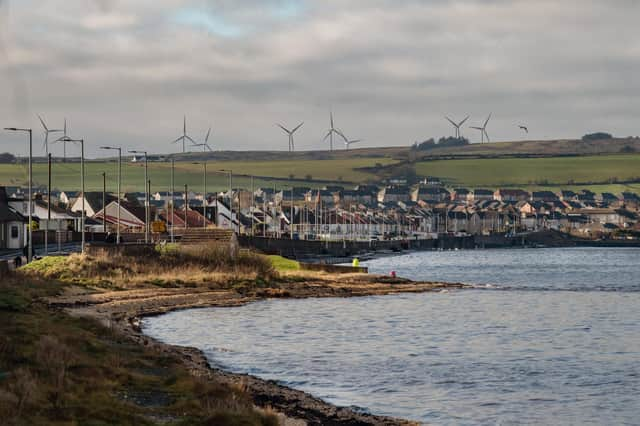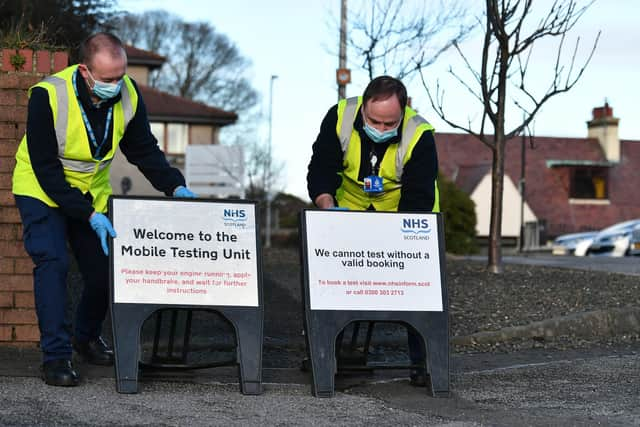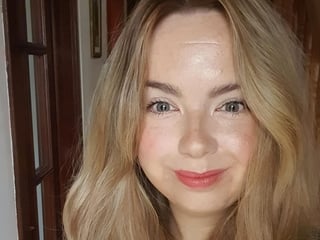Insight: Stranraer, the small town branded Scotland's 'Covid Capital'


But the notices so crowded the window of Dunns Newsagents in Stranraer they obscured almost all the glass, after the first major outbreak of Covid-19 the town has seen since the beginning of the pandemic.
From just after Christmas to the third week of January, seven day case rates in this area of a few thousand people reached over 400 per 100,000 population, among the worst in Scotland, with numbers only now beginning to drop.
Advertisement
Hide AdAdvertisement
Hide AdA major outbreak in a local care home contributed to the chilling figures, with 46 residents testing positive in a 60-bed care home, and 14 lives lost.


A large part of the new cases have been attributed to the new variant of Covid-19 first identified in Kent. Cases were identified early on in Wigtownshire, lower Annandale and Eskdale, according to NHS Dumfries and Galloway, and by late January the new variant accounted for over 80 per cent of local cases - a higher proportion that for Scotland as a whole, where it represented just over half of cases.
At the peak on January 12 National Clinical Director Jason Leitch called Dumfries and Galloway an example of the cruel nature of Covid-19, as the area went from “almost no cases to the highest in the country in three weeks”.
Local residents have been shocked by the sudden wave of cases.
“It’s not nice to hear that your home town is the one with the worst record,” says Chair of the Community Council Hamilton McMillan.
“I have to say it’s a shock to the whole town that it hit us that hard that quickly.”
Fear has spread “through the whole community,” says local independent councillor Willie Scobie.
The attention inspired by high case numbers has not been welcome, and some members of the local community talk of a “nasty atmosphere” on social media.
Advertisement
Hide AdAdvertisement
Hide AdMany in the town would like the news reports to stop, but others say they are welcome and necessary, to “wake people up” and underline how vital it is to follow the rules around Covid-19.
Several are happy to speak about the issue in order to raise awareness, but do not want to be named for fear of online backlash.
“It’s been the elephant in the room,” one local says, “but nobody wanted to talk about it.”
“Everybody’s looking for someone to blame. We have several theories from all different sides.
“People are saying it’s folk coming in, that somebody brought it from Faslane, that it’s the camper vans… people are looking for someone to blame, which is understandable, but it’s a perfect storm.
“Regardless of what the rumour is and what people are saying, the Kent variant did get into the community and before people knew about it it had spread.”
Another local is worried about her elderly parents, who are in their 80s.
“It’s shocking,” she says.
“I’m worried as it’s a small community yet so many people have it and so many people have died lately. My parents are elderly and haven’t been out in months.”
Advertisement
Hide AdAdvertisement
Hide AdShe adds: “Many thought they were immune during the first outbreak as they had so few cases and because Stranraer is geographically out of the way [...] even when so many have died some still have the opinion that it won’t happen to them.”
There is anger among some people that the area was moved to Level One restrictions before Christmas.
“For a small town to have lost so many it’s terribly sad. Personally I blame tier one and people’s approach of thinking they had such low cases prior to tier one, so they were invincible.”
Another local resident also feels the Level One decision was to blame for the recent outbreak.
“I believe putting Dumfries and Galloway into Level One on around the 11th of December caused a massive surge in visitors,” they say.
“The pubs were open inside! We had people from England, Ayrshire and the Central Belt.
“I really, really want the levels system to be stopped - it should be all or nothing as so many people are coming to the low level areas [...] I wish I could shout from the rooftops to stop the tiers/levels as rural areas are paying the price for this.”
The area was “overrun” with visitors, they say.
“I would think most people weren’t happy about visitors. We were absolutely overrun all summer long but I believe the opening of pubs etc in level One was the major contributor to the massive rise in cases.
Advertisement
Hide AdAdvertisement
Hide Ad“It was the week running up to Christmas, pretty much everyone that went to the pub ended up with the virus. We also had people from Ayrshire etc in the cafes, bookies, trains, shops...
One woman who lives in a nearby town complains of the area “heaving with tourists” after Level One was introduced.
“The thing I noticed, and my husband too, was, as soon as Nicola Sturgeon announced we were going down to tier one, the amount of visitors that flooded the Machars and Rhins was horrendous,” she says.
“The supermarket where I do most of my shopping was heaving with tourists. The staff told me that it had been so busy and most of the customers were not locals.”
A recurring theme among discussions with locals is that they have been “forgotten about” by the Scottish Government.
“They only seem to care about the Central Belt and above. When questioned about the numbers in Dumfries and Galloway, [Nicola Sturgeon] more or less avoided saying anything about it,” one says.
“She went back to talking about the numbers in the Central Belt. It's like everything else in this area, the SNP are not interested as historically we are a Tory voting region.”
Ms Sturgeon was asked about the high number of cases in Dumfries and Galloway in the Coronavirus daily briefing on January 12, and asked about a recent question from South Scotland MSP Emma Harper about a permanent walkthrough testing centre in Stranraer.
She said she would “consider” a testing centre.
Advertisement
Hide AdAdvertisement
Hide Ad“Getting testing facilities to people as closely and accessibly as possible has always been the approach we take and we will always look to see whether there is a need to do more of that,” she said.
“We will consider the Stranraer point, even if it’s not a permanent walkthrough centre, whether there’s a need for more mobile testing capacity to be deployed there over the next period.”
Recently mobile testing units have been available in Stranraer two days a week.
“We should have been doing a lot more testing,” says Councillor Willie Scobie.
“We should have been applying mass testing in Stranraer to try and cut down the spread of this, it was rapidly spreading through the community. How was it taken into Thorney Croft? We don’t know.”
For him, it is “huge neglect” on the part of the Scottish Government that more testing was not put in place.
“[The question to Nicola Sturgeon]“ was two weeks ago. There is huge neglect as to what they should have been doing in Stranraer, with such a high peak of cases,” he said, adding: “When she was asked that question, she should have acted immediately. And she hasn’t.”
“The people in Stranraer are living in fear, they’re totally frightened. It’s worse for the families of those living in Thorney Croft, that is catastrophic,” he says.
Testing had been available more regularly before January 8.
Advertisement
Hide AdAdvertisement
Hide Ad“I know the numbers have started to level out, but I still think we need some concerted effort and a nice strong message for the people of Stranraer, whether it’s more mobile testing visits or establishing a small walkthrough centre, because even though the numbers have reduced they’re still pretty high,” said Emma Harper, earlier this week.
“I’m just asking for equity for the people, to make sure they know that everything is being done that could be done, because there’s a lot of worried folk in the Stranraer area, because they’ve seen the Covid cases at the care home rising.
“Everybody knows everybody in Stanraer, this is a community that’s strong and resilient, but I want to make sure I support them.”
Ms Harper received a response to her question from Mairi Gougeon, Public Health Minister, on Friday, saying the Scottish Government plans to increase testing from two days a week to seven.
NHS Dumfries and Galloway say testing in the area has been adequate.
“Although numbers of cases have declined within Wigtownshire, this week daily testing has once again been taking place based in Stranraer, operating well within capacity, and with a second unit on its normal frequency in Newton Stewart,” a spokesperson said.
“We continue to have discussions with national testing colleagues around the
potential for securing additional testing capacity as and where it is available and
can be successfully applied.”
Advertisement
Hide AdAdvertisement
Hide AdAsked about locals’ complaints that Stranraer has been “forgotten about”, the Scottish Government says too that testing has been sufficient.
“Testing has been available in Stranraer throughout January through a mobile unit testing that moves around Dumfries and Galloway,” said a spokesperson.
“In addition, the Scottish Ambulance Service allocated a dedicated mobile testing unit to Stranraer on Tuesday 26 January which will stay as long as it is required. This mobile additional mobile testing unit is able to take drive-through and walk-in tests from 11am to 4pm seven days a week.”
When asked in early January why cases had begun to rise so suddenly in the south of Scotland, Nicola Sturgeon said there were “deep and complex reasons” for the spread, but highlighted both the new variant and travel.
“We have a new strain of the virus that is transmitting 70 per cent more easily, that is why it has happened,” she said.
Referencing Dumfries and Galloway and the Borders, she said: "These are areas we moved down into level one not long before the end of the year because case incidence was so low.
“But the virus has this new strain, and it has got in there. That will undoubtedly be to some extent travel-related, with people who will have brought it either returning from elsewhere in the UK or coming from elsewhere in the UK, but it is spreading very quickly."
Not everyone is keen to identify a cause of the outbreak.
“There’s no point putting blame on anybody. Hindsight is a great thing, but nobody knows how to deal with this, because it’s never happened before,” says Hamilton McMillan, adding that the community needs to pull together, help each other, and get on with it.
Advertisement
Hide AdAdvertisement
Hide AdThere are likely to be several reasons for the sudden surge of cases in this isolated corner of Scotland.
As case numbers begin to further drop one thing is certain: the community would like to put their moment of renown as “Scotland’s Covid Capital” far behind them.
A message from the Editor:
Thank you for reading this article. We're more reliant on your support than ever as the shift in consumer habits brought about by coronavirus impacts our advertisers.
If you haven't already, please consider supporting our trusted, fact-checked journalism by taking out a digital subscription.
Comments
Want to join the conversation? Please or to comment on this article.
